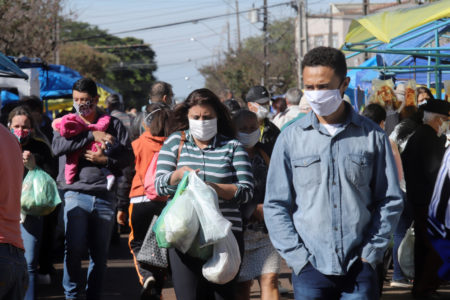Share On Social!
Have you ever wondered how your county compares to others in healthcare, education, and opportunities?
County Health Rankings & Roadmaps is a program by the University of Wisconsin Population Health Institute and Robert Wood Johnson Foundation that measures health disparities in different counties based on local data to help improve health and quality of life.
The 2021 update of the County Health Rankings reflect the inequities worsened by the COVID-19 pandemic and shines a brighter lens on racial equity and justice.
“And while the Rankings do not measure COVID-19 risk, they do help to show the root causes that contribute to poor health. Creating conditions for everyone to thrive requires looking to multi-layered social, economic, and structural factors that run much longer and deeper in communities than mask-wearing or safer at home orders. We are committed to addressing the deeper systemic issues,” according to the County Health Rankings website.
What’s in the 2021 County Health Rankings Update?
The 2021 County Health Rankings point out that Latinos and other people of color have been hurt the most under the pandemic.
“While all are suffering, those who came into the pandemic with the fewest opportunities are likely to exit it with an even greater burden. This crisis has only deepened the avoidable and unfair gaps that Black, Latino, Indigenous, and some Asian-American communities faced pre-COVID-19 in jobs with fair pay, housing, education, and more,” according to the County Health Rankings website.
 The County Health Rankings also have a new feature to compare counties in quartiles of least healthy to healthiest.
The County Health Rankings also have a new feature to compare counties in quartiles of least healthy to healthiest.
“Looking at the underlying data and how those data have changed over time provides a better picture of your county’s progress. Health Outcome and Health Factor rankings are grouped into four equally sized groups (quartiles), ranging from the least healthy to healthiest counties (Lowest 0-25%, Lower 25-50%, Higher 50-75%, or Highest 75-100%) within each state. A county with a rank of #1 lies in the Healthiest (Highest 75-100%) quartile,” according to the County Health Rankings website.
Despite the change in displaying rankings, the program will continue to monitor the same health outcomes and factors, such as length and quality of life, health behaviors, clinical care, social and economic factors, and physical environment.
They team behind the County Health Rankings hope that their data will be a helpful part of creating change.
They also have a plan to improve how they advocate for equity with the following points:
- Engage with leaders from impacted communities who are working to advance health equity
- Assess how the County Health Rankings model works to explore the fundamental causes of health.
- Investigate new sources and measures to more effectively capture differences in health and living opportunities
- Add more topic-focused curated lists to their What Works for Health feature, which is a menu of evidence-informed policies and strategies.
“We know data alone is not sufficient to advance change. As we evolve our model, data, and measures; leverage partner relationships; synthesize perspectives from the most impacted communities; and improve our tools and website, we believe all of these efforts will work together to contribute to transformative change and action across the nation,” according to the County Health Rankings website.
Let’s take a look at how a county with a predominately Latino population compares to a white majority county.
Comparing Predominately White and Latino Counties
County Health Rankings found that communities of color are more affected by health disparities and more likely to have worse access to opportunities for healthy lifestyles.
When looking at the data from a majority Latino county and how it compares to an affluent, majority white county, it is evident that the county with the larger Latino population has worse health disparities.
Chittenden County, VT
Chittenden County, Vermont is a predominately white, affluent county that is used in comparison to a majority Latino county.
Chittenden County is ranked in the highest percentile for health outcomes and health factors.
The following are health factors indicated for Chittenden County on the County Health Ranking website:
- Access to exercise opportunities: 87%
- Uninsured population: 4%
- High school completion: 94%
- Children in poverty: 8%
- Unemployment: 1.8%
Hidalgo County, TX
Hidalgo County, Texas is a predominately Latino county on the Texas-Mexico border. The area is often hurt by natural disasters and the effects of poverty.
Hidalgo County is ranked in the lowest percentile for health factors.
The following are health factors indicated for Hidalgo County on the County Health Ranking website:
- Access to exercise opportunities: 59%
- Uninsured population: 32%
- High school completion: 66%
- Children in poverty: 37%
- Unemployment: 6.2%
These rankings highlight many unfortunate truths about the lack of access to health opportunities in Latino communities.
While the uninsured population in Chittenden County is only 4%, it is almost a third of the population in the predominately Latino Hidalgo County.
The Affordable Care Act improved health insurance coverage for Latinos, but the uninsured rate remains higher among Latino (25.1%) than white adults (8.5%), according to a Salud America! research review.
Children in poverty also vary drastically between the two counties, with 8% in the predominately white county and 37% in the predominately Latino county.
This is consistent with national data – child poverty rates are more than twice as high for Latino children than white children (23.7% vs 8.9%).
“Poverty’s material hardships ─ difficulty meeting basic food, medical, housing, and transportation needs ─ lead to worse health and life outcomes,” according to a Salud America! research review.
High school completion also varies drastically, with 94% in Chittenden County and only 66% in Hidalgo County.
Latino students tend to have a higher high school dropout rate than other groups, which can have negative effects on future opportunities in life.
“The high school dropout rate among Latino students is 17.6%; higher than Black (9.3%) and White students (5.2%). Lower educational attainment among Black and Latino students is linked to an increased risk of institutionalization, poorer physical and mental health, and reduced lifetime earning/economic potential,” according to a Salud America! research review.
The evidence is clear that action and policies are needed to address these health disparities affecting Latinos.
How Can We Address Health Disparities?
Addressing health disparities in Latino communities is important to give everyone equitable access to the opportunity to live a healthy life.
Through their What Works for Health feature, County Health Rankings provides strategies, policies, and programs that have been shown to improve the different health factors:
- To increase high school graduation rates, some suggested programs are dropout prevention GED certificate, and mentoring.
- To reduce barriers to healthcare, County Health Rankings suggests health insurance enrollment outreach, rural transportation services, and health literacy interventions.
- To combat poverty, they suggest policies like childcare subsidies, wage increases, and income tax credits.
“Increasing opportunities for everyone can reduce gaps in health,” according to the County Health Rankings website.
Another way we can advocate for health equity is by downloading a Health Equity Report Card.
The Health Equity Report Card by Salud America! at UT Health San Antonio lets you see many local children are living in poverty and food deserts, what access to education and healthcare your neighbors have, and how many households get access to SNAP food benefits.
Then you can email your Health Equity Report Card to community leaders, share it on social media, and use it to make the case to address inequities where help is needed most!
By The Numbers
23.7
percent
of Latino children are living in poverty



